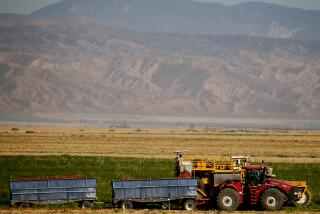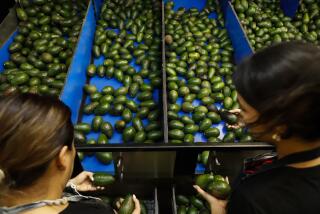Avocado Growers Slash Groves by One-Third to Save Thirsty Trees : Agriculture: Farmers across the county are thinning their orchards in response to the drought and water cuts.
- Share via
Warren Henry could only shrug off the irony as he stood, damp, in the drizzle.
In an effort to demonstrate the effects of the drought and impending water shortages, the Henry Avocado Co. and the San Diego County Farm Bureau held a press conference Wednesday showing avocado farmers cutting down a third of their trees in an effort to save the rest of the crop.
Henry, who owns one of the largest and oldest avocado groves in the county, has thinned his groves before but never because of drought.
“We’ve never had a drought like this before,” said Henry, whose father began growing avocados in Escondido in 1925. “And we’ve never been cut back on water before.”
Henry, who usually grosses more than $1 million from his 300 acres of avocados, said earnings this year will drop to about $600,000.
“We’re picking the fruits smaller and picking them early,” Henry said.
But the real losses will come over the next two years when there will be at least one-third fewer trees, Henry said. And even if rainfall picks up next year, it will take as long as four years for the trees to recover.
In 1989, avocados accounted for $108 million of the county’s $772 million total crop value. San Diego County alone accounts for half of the state’s avocado crop.
“I’d like to stall a little longer, because we may get a good rain yet,” said Henry, who cringes at the thought of having to cut down another 20% of his orchard if reports of a 50% water cutback become reality.
Henry said it is normal to thin groves occasionally, but never has he cut down more than 10% of his trees for any reason.
Henry has been in the avocado business for the past 40 years, having followed his father into the business.
Asked if his avocado grove will be able to weather the drought, Henry said, “I have to, it’s all I know.”
Bill Snodgrass of the county’s Department of Agriculture, Weights and Measures said avocado growers across the county are cutting down trees.
Crops that grow on trees, such as avocados, would weaken and become diseased without adequate water, Snodgrass said. By cutting some of the trees down, the stumps of those trees will be able to live with less water while letting the other trees flourish.
“These are permanent crops. You can’t just stop watering your crops one year and expect to come back the next,” Snodgrass said. “When you pull out trees it affects not only this year, but the next year and the next.”
Charley Wolk, immediate past president of the San Diego County Farm Bureau, said “Avocados are probably particularly sensitive to the drought because you have to have a lot of water.”
During peak watering, avocados need at least 30 gallons a day, compared to oranges and apples, which consume 22 gallons and 16 gallons of water a day, respectively.
Also on Wednesday, Escondido city officials unveiled a draft of their water conservation program, which includes fines and surcharges up to $1,500 and 30-day jail terms for violators.
“We don’t say that this will be the gospel,” said Cynthia Ferguson-Salvati, water conservation and reclamation administrator for Escondido. “It has to be a very dynamic document.”
The draft ordinance allows for exceptions to be granted and for various means of appeal. But Ferguson-Salvati said the city must balance its desire to have an agricultural base with the needs of the residents.
“The community here has said we really like agriculture, we like the way it looks and what it offers, and maybe it’s in the best interests of the city to support agriculture,” Ferguson-Salvati said. Agriculture in Escondido accounts for 25% of all water usage in the city.
More to Read
Sign up for Essential California
The most important California stories and recommendations in your inbox every morning.
You may occasionally receive promotional content from the Los Angeles Times.










